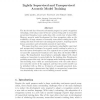1092 search results - page 143 / 219 » Abbreviated text input using language modeling |
AIHC
2007
Springer
14 years 5 months ago
2007
Springer
Enabling machines to understand emotions and feelings of the human users in their natural language textual input during interaction is a challenging issue in Human Computing. Our w...
BMCBI
2008
13 years 11 months ago
2008
Background: Prediction of transmembrane (TM) helices by statistical methods suffers from lack of sufficient training data. Current best methods use hundreds or even thousands of f...
LREC
2010
14 years 17 days ago
2010
In this paper, we present a modeling of the syntactic lexicon for Arabic verbs based on the Lexical Markup Framework. This ISO standard let us describe the lexical information in ...
CSL
2002
Springer
13 years 11 months ago
2002
Springer
The last decade has witnessed substantial progress in speech recognition technology, with todays state-of-the-art systems being able to transcribe unrestricted broadcast news audi...
TKDE
1998
13 years 10 months ago
1998
—This paper describes a unified data model that represents multimedia, timeline, and simulation data utilizing a single set of related data modeling constructs. A uniform model f...



